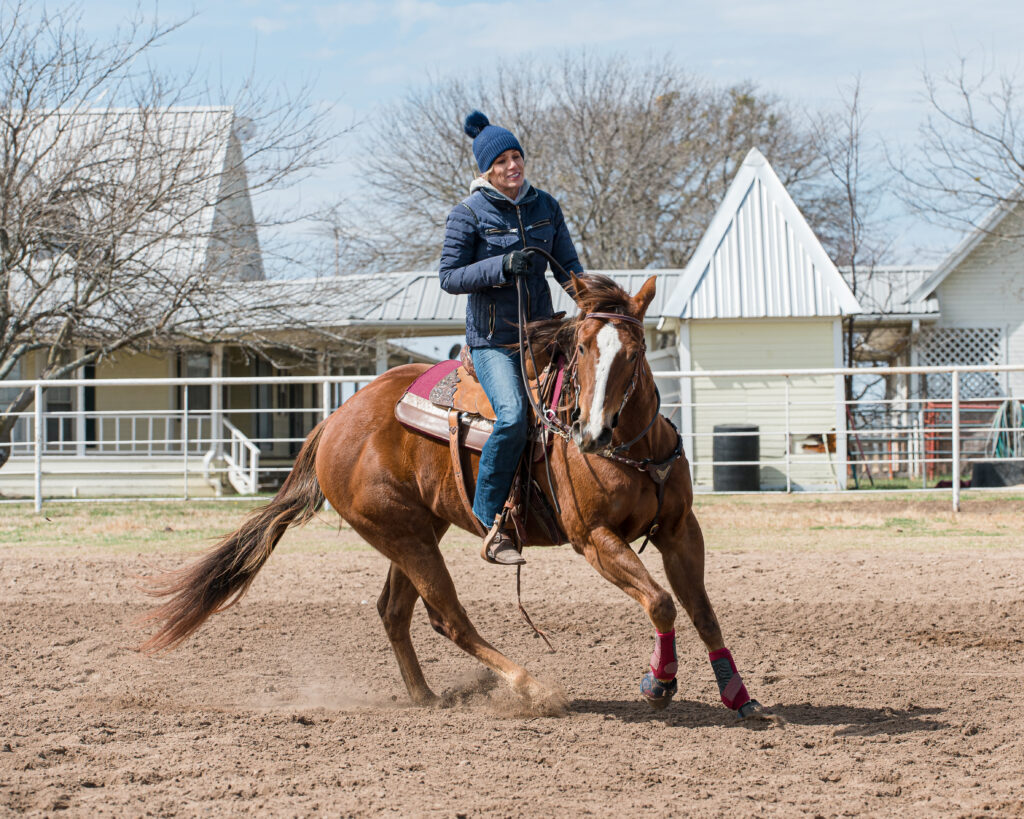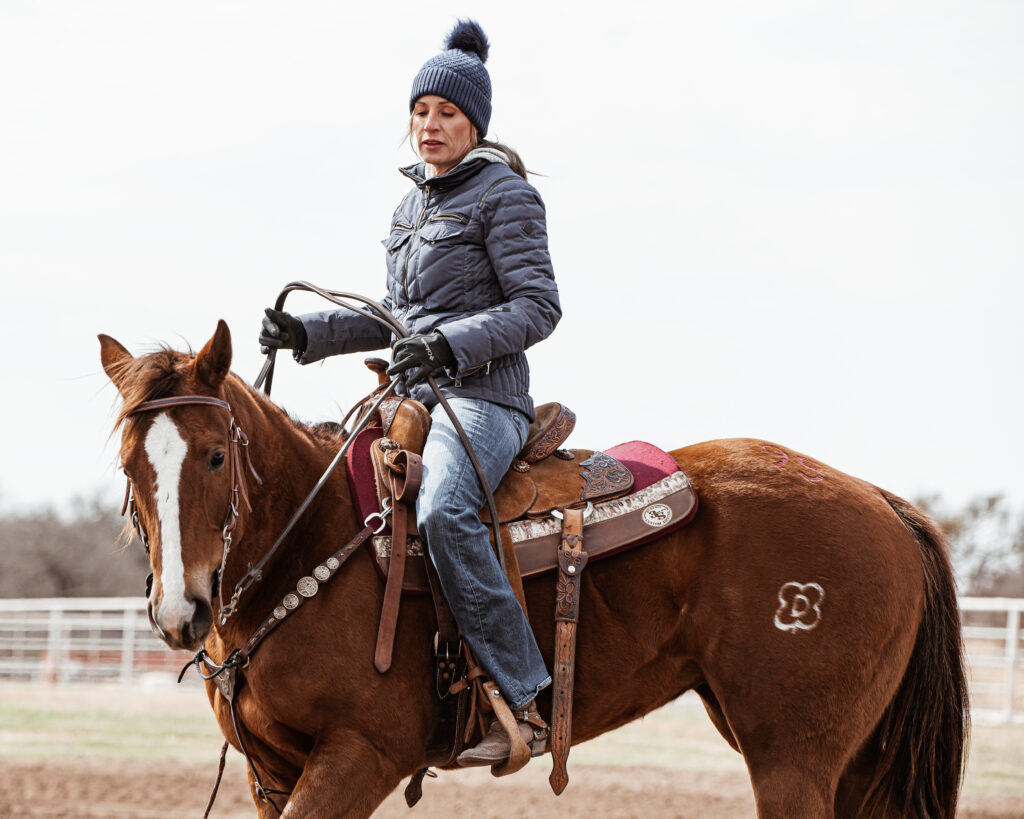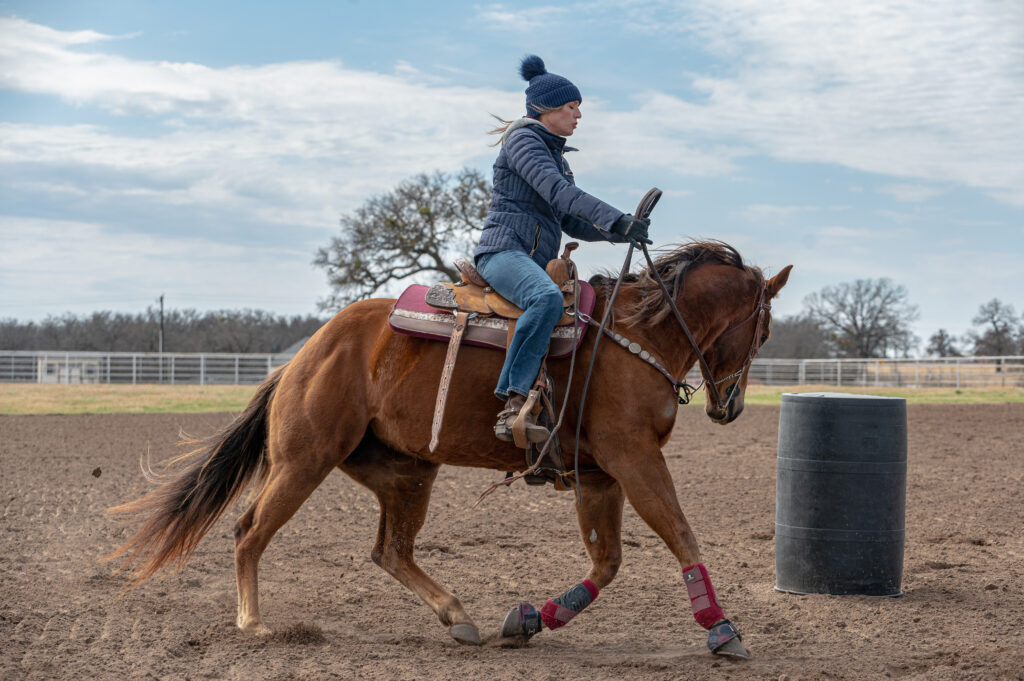Professional barrel horse trainer, clinician and multiple National Finals Rodeo qualifier Danyelle Campbell treated Barrel Racing Magazine to a day at her facility near Weatherford, Texas, where we soaked up her rich wealth of knowledge. Campbell’s style is proven at all levels of the game, from professional rodeo to the highest echelon of futurity and derby competition.
| READ Storybook Ending for Return Of The Mac at BFA World Championship Futurity
To keep the lines of communication as straight-forward as possible between her hands and her horse’s mouth, Campbell is disciplined about riding with proper elbow position and teaching that foundational pillar to those she coaches.
“I always keep my elbows bent 90 degrees. I’m very big on arm and elbow control, like huge,” Campbell said. “I’ve learned this by doing clinics. I feel that it’s something I did naturally, but then I never understood the importance until I tried teaching people who didn’t. Their elbows were out, or even if their hand was kind of in the right place then their elbows flapped. That affects the angle of your hands and your pull.”
When Campbell coaches, she is emphatic about riders keeping their elbows in contact with their torso rather than “flapping” out away from their body.
“It was incredible how it helped, and how they noticed it would help,” she said. “It gives you something to stabilize your arms. I don’t believe that there’s a 100 percent right or wrong place to put your hands. I think your horses tell you a little bit where they want them to be. I’m not a believer in low hands, I don’t like my hands on their neck. I want a straight 90 degrees, keeping my elbows close to my body. If I pull back, I come straight back.”

Campbell says she’ll ride with higher hands, but is always aware of keeping her elbows close to her body while not ever letting her hand come toward the center of the horse’s neck.
“Rather than bringing my hand across the neck, I’m just going to drive them forward with my feet,” she said. “I believe that in our sport, and most, if you can get those fluid transitions it applies to what happens when we go fast. I want my horses to move their body based off what my body’s telling them.”
Further pinpointing where she needs her hands to be in order to effectively cue the horse she’s riding Campbell says she uses the waist of her jeans as a guide for position.
“I want my hand directly on the side of my hip. I want it directly on top of my pants. To me, that’s the ideal hand position for me teaching horses,” she said.

“Everything that I do with my hands correlates to what I’m doing with my legs, and ultimately, it’s just creating a soft, collected horse that’s capable of doing anything I’m asking them to do.”
Keep the Ribcage Right
When using her hands and feet to train soft, responsive equine partners, Campbell’s goal is to make sure her horses are broke through the ribcage.
“I believe everything that goes awry all comes from their ribcage, not their face,” Campbell said. “Anytime I have, or see, a horse hollow out, fall out of a turn, anything, it’s never the mouth. It’s never the head. It’s always your legs. I can feel it when it happens to me, so when I ride, I’m trying to undo all those braces.”

“I don’t let that outside rein touch the neck, so I’m always breaking them loose here. This is 100 percent why my hands are where they are. I can sit there and give 20 lessons a day to 20 different people, and you can see when a horse gets tight and stiff, and you tell them to squeeze with their inside leg, all the sudden that horse will melt, and they will start striding forward.”
Campbell says cross-firing in the hind end is a bi-product of riders failing to maintain the horse’s forward momentum via ribcage collection.
“The only physical way they can mechanically cross-fire behind is if the front end is going slower than the hind end,” she said. “The mechanics of a horse, in my opinion, when riding with people of every discipline and some of the best in the world, and myself riding all different types of horses, I have never had a horse in a circle switch to the wrong lead behind that did not slow the front end down to some degree. The front legs always have to be free and reaching. In my training, and what I do to attain that, is having them broke in the ribs.”
Campbell further clarifies that broke in the ribcage means more than just bent—it means the horses have to maintain collection.
“For me, pretty much anytime I say broke, it means collection,” she said. “I don’t ever focus on hips being in, but I do focus on the front end being up, having that collection and driving forward. Everything I believe about how I want a horse to move directly correlates to how I’m positioning my hands to achieve this.
“I feel like that’s a super important part horsemanship-wise for anybody—learn what you can do with your body and your feet without doing everything with your hands,” she said. “Watch Kassie Mowry run. Her hands do so much more than people realize, but they do it without moving. You don’t see them moving, but she’s teaching her horses to respond with that little bit of movement, which is so much more effective than telling them to do everything.”
Campbell also emphasizes that sometimes in the heat of battle horses do have to take a pull or deal with an abrupt hand movement.
“I will pull a horse when I want them to take a pull, but the only way they can ‘take a pull’ is when their body is soft enough to take that pull,” she said. “Everything I do comes into getting ready for actual running.”
Check back soon for more with Danyelle Campbell and her thoughts on collection, riding one-handed versus two-handed and much more.






